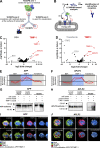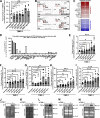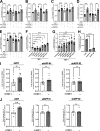TIMP-1 is a novel ligand of Amyloid Precursor Protein and triggers a proinflammatory phenotype in human monocytes
- PMID: 36629908
- PMCID: PMC9837626
- DOI: 10.1083/jcb.202206095
TIMP-1 is a novel ligand of Amyloid Precursor Protein and triggers a proinflammatory phenotype in human monocytes
Abstract
The emerging cytokine tissue inhibitor of metalloproteinases-1 (TIMP-1) correlates with the progression of inflammatory diseases, including cancer. However, the effects of TIMP-1 on immune cell activation and underlying molecular mechanisms are largely unknown. Unbiased ligand-receptor-capture-screening revealed TIMP-1-interaction with Amyloid Precursor Protein (APP) family members, namely APP and Amyloid Precursor-like Protein-2 (APLP2), which was confirmed by pull-down assays and confocal microscopy. We found that TIMP-1 triggered glucose uptake and proinflammatory cytokine expression in human monocytes. In cancer patients, TIMP-1 expression positively correlated with proinflammatory cytokine expression and processes associated with monocyte activation. In pancreatic cancer, TIMP-1 plasma levels correlated with the monocyte activation marker sCD163, and the combined use of both clinically accessible plasma proteins served as a powerful prognostic indicator. Mechanistically, TIMP-1 triggered monocyte activation by its C-terminal domain and via APP as demonstrated by in vitro interference, in silico docking, and the employment of recombinant TIMP-1 variants. Identification of TIMP-1 as a trigger of monocyte activation opens new therapeutic perspectives for inflammatory diseases.
© 2023 Eckfeld et al.
Conflict of interest statement
Disclosures: The authors declare no competing interests exist.
Figures







Similar articles
-
Identification of invariant chain CD74 as a functional receptor of tissue inhibitor of metalloproteinases-1 (TIMP-1).J Biol Chem. 2021 Sep;297(3):101072. doi: 10.1016/j.jbc.2021.101072. Epub 2021 Aug 12. J Biol Chem. 2021. PMID: 34391782 Free PMC article.
-
Natural haemozoin induces expression and release of human monocyte tissue inhibitor of metalloproteinase-1.PLoS One. 2013 Aug 14;8(8):e71468. doi: 10.1371/journal.pone.0071468. eCollection 2013. PLoS One. 2013. PMID: 23967215 Free PMC article.
-
Relevance of amyloid precursor-like protein 2 C-terminal fragments in pancreatic cancer cells.Int J Oncol. 2012 Oct;41(4):1464-74. doi: 10.3892/ijo.2012.1553. Epub 2012 Jul 13. Int J Oncol. 2012. PMID: 22797723 Free PMC article.
-
Cut loose TIMP-1: an emerging cytokine in inflammation.Trends Cell Biol. 2023 May;33(5):413-426. doi: 10.1016/j.tcb.2022.08.005. Epub 2022 Sep 23. Trends Cell Biol. 2023. PMID: 36163148 Review.
-
Beneficial and detrimental influences of tissue inhibitor of metalloproteinase-1 (TIMP-1) in tumor progression.Biochimie. 2005 Mar-Apr;87(3-4):377-83. doi: 10.1016/j.biochi.2004.09.022. Biochimie. 2005. PMID: 15781325 Review.
Cited by
-
Tissue Inhibitor of Matrix Metalloproteinases-1 (TIMP-1) and Pulmonary Involvement in COVID-19 Pneumonia.Biomolecules. 2023 Jun 26;13(7):1040. doi: 10.3390/biom13071040. Biomolecules. 2023. PMID: 37509076 Free PMC article.
-
Amyloid precursor-like protein 2 expression in macrophages: differentiation and M1/M2 macrophage dynamics.Front Oncol. 2025 Apr 8;15:1570955. doi: 10.3389/fonc.2025.1570955. eCollection 2025. Front Oncol. 2025. PMID: 40265027 Free PMC article.
-
Peripheral blood amyloid-β involved in the pathogenesis of Alzheimer's disease via impacting on peripheral innate immune cells.J Neuroinflammation. 2024 Jan 4;21(1):5. doi: 10.1186/s12974-023-03003-5. J Neuroinflammation. 2024. PMID: 38178136 Free PMC article. Review.
-
The TIMP protein family: diverse roles in pathophysiology.Am J Physiol Cell Physiol. 2024 Mar 1;326(3):C917-C934. doi: 10.1152/ajpcell.00699.2023. Epub 2024 Jan 29. Am J Physiol Cell Physiol. 2024. PMID: 38284123 Free PMC article. Review.
-
Immune Dysregulation and Hub Gene Identification in Non-Pulmonary Sepsis-Induced Acute Lung Injury: Insights from Transcriptomic and Experimental Analyses.Curr Med Sci. 2025 Jul 1. doi: 10.1007/s11596-025-00083-7. Online ahead of print. Curr Med Sci. 2025. PMID: 40591166
References
-
- Bruchez, A., Sha K., Johnson J., Chen L., Stefani C., McConnell H., Gaucherand L., Prins R., Matreyek K.A., Hume A.J., et al. . 2020. MHC class II transactivator CIITA induces cell resistance to Ebola virus and SARS-like coronaviruses. Science. 370:241–247. 10.1126/science.abb3753 - DOI - PMC - PubMed
Publication types
MeSH terms
Substances
Grants and funding
LinkOut - more resources
Full Text Sources
Research Materials
Miscellaneous

